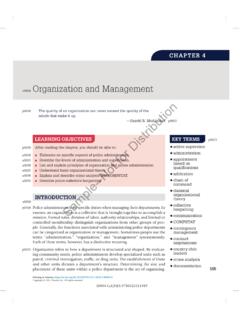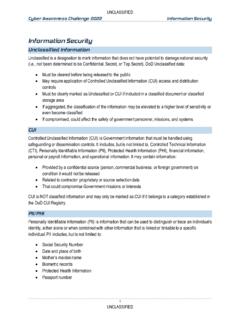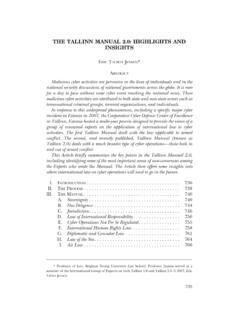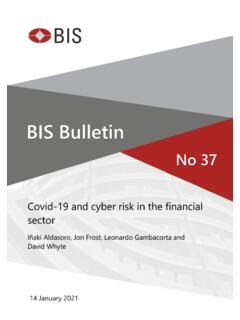Transcription of Network Security Basics - Elsevier
1 1 Chapter 1 Solutions in this chapter: Security Overview Defi ning Basic Security Concepts Addressing Security Objectives Recognizing Network Security Threats Designing a Comprehensive Security Plan SummaryNetwork Security Basics2 Chapter 1 Network Security you can understand fi rewalls and how ISA Server 2006 works, you need to look at the big picture: what we mean by Network Security in general and Internet Security in particular why it s necessary, how we can create a comprehensive Security policy to protect our networks from unauthorized access, and where ISA Server fi ts into that Security is a big topic and is growing into a high profi le (and often highly paid) Information Technology (IT) specialty area.
2 Security -related websites are tremendously popular with savvy Internet users. The popularity of Security -related certifi cations has expanded. Esoteric Security measures like biometric identifi cation and authentication formerly the province of science fi ction writers and perhaps a few ultra-secretive government agencies have become commonplace in corporate America. Yet, with all this focus on Security , many organizations still implement Security measures in an almost haphazard way, with no well-thought-out plan for making all the parts fi t together. computer Security involves many aspects, from protection of the physical equipment to protection of the electronic bits and bytes that make up the information that resides on the the next section, we will provide a brief overview of what we mean by Security and how it applies to your computer chapter focuses on generic computer and Internet Security concepts and how to develop a comprehensive Security plan for your organization.
3 The rest of this book will discuss how ISA Server fi ts into that Security OverviewThe term computer Security encompasses many related, yet separate, topics. These can be stated as Security objectives, and include: Control of physical accessibility to the computer (s) and/or Network Prevention of accidental erasure, modifi cation or compromise of data Detection and prevention of intentional internal Security breaches Detection and prevention of unauthorized external intrusions (hacking) Network Security solutions are loosely divided into three categories: hardware, software and human.
4 In this chapter, we will provide an overview of basic Security concepts. Then, we will examine the four Security objectives and look at each of the three categories of Security ning Basic Security ConceptsA generic defi nition of Security is freedom from risk or danger; safety (The American Heritage Dictionary). Network Security Basics Chapter 1 defi nition is perhaps a little misleading when it comes to computer and networking Security , as it implies a degree of protection that is inherently impossible in the modern connectivity-oriented computing is why the same dictionary provides another defi nition specifi c to computer science: The level to which a program or device is safe from unauthorized use [emphasis added].
5 Implicit in this defi nition is the caveat that the objectives of Security and accessibility the two top priorities on the minds of many Network administrators are, by their very natures, diametrically opposed. The more accessible your data is, the less secure it is. Likewise, the more tightly you secure it, the more you impede accessibility. Any Security plan is an attempt to strike the proper balance between the in any other specialty fi eld, Security professionals speak a language all their own and understanding the concepts requires that you learn the jargon. At the end of this section, you will fi nd a list of some common terms that you are likely to encounter in the IT Security fi is PowerThe above title is a famous hacker s motto (along with such other gems as Information wants to be free, and the simplistic but optimistic, Hack the world!)
6 However, it is a truism that applies not only to those attempting to gain access to data they aren t supposed to see, but also to those who are trying to protect themselves from the intruders. The fi rst step in winning any battle and Network Security is a battle over the ownership and control of your computer fi les is the same as it s always been: know thine enemy. To protect your Network resources from theft, damage, or unwanted exposure, you must under-stand who initiates these things, why, and how they do it. Knowledge will make you powerful, too and better able to prevent unauthorized intrusions into your Network .
7 In the section entitled Detecting and Preventing Unauthorized External Intrusions, we will discuss the various motivations that drive different Network intruders and the types of people who make a practice of breaking and entering very best place to learn is from the hackers themselves. Many Network administrators and even some Security specialists eschew the books and websites that are written to a hacker audience or from the hacker s point of view. This may be because one fears guilt by association or believes that it would be somehow demeaning to hang out with the hackers. This attitude may be based on high moral ground, but strategically, it s a Like a ThiefIt is well known in law enforcement circles that the best criminal investigators are those who are best able to get inside the mind of the lawbreaker.
8 Network intrusion detectives will fi nd that the same is true to prevent your Network from falling prey to hackers, or to catch data thieves when they do get in, requires that you be able to adopt a mindset emulating means learning to anticipate the intruder s actions. First, you must determine what needs to be protected, and to what degree. A wealthy person not only establishes a general Security perimeter by building fences around the house and locking doors and windows, but also places the most valuable items in a wall or fl oor safe. This provides multiple layers of protection. The practice of implementing multiple layers of protection is known as defense in Server can be an important layer of protection in your organization s Security Chapter 1 Network Security Intrusion TriangleBorrowing again from the law enforcement community, crime prevention specialists use a model called the Crime Triangle to explain that certain criteria must exist before a crime can occur.
9 We can adapt this same triangle to Network Security : the same three criteria must exist before a Network Security breach can take place. The three legs or points of the triangle are shown in Figure All three legs of the triangle must exist for a Network intrusion to occurLet s look at each point individually: Motive: An intruder must have a reason to want to breach the Security of your Network (even if the reason is just for fun ); otherwise, he/she won t bother. Means: An intruder must have the ability (either the programming knowledge, or, in the case of script kiddies, the intrusion software written by others), or he/she won t be able to breach your Security .
10 Opportunity: An intruder must have the chance to enter the Network , either because of fl aws in your Security plan, holes in a software program that open an avenue of access, or physical proximity to Network components; if there is no opportunity to intrude, the would-be hacker will go you think about the three-point intrusion criteria for a moment, you ll see that there is really only one leg of the triangle over which you, as the Network administrator or Security specialist, have any control. It is unlikely that you can do much to remove the intruder s motive. The motive is likely to be built into the type of data you have on the Network or even the personality of the intruder him/herself.







![[hs] Cyber Security for Beginners 0](/cache/preview/4/3/8/2/9/c/3/0/thumb-43829c3034a96ab5916d2587eb53ac7a.jpg)




